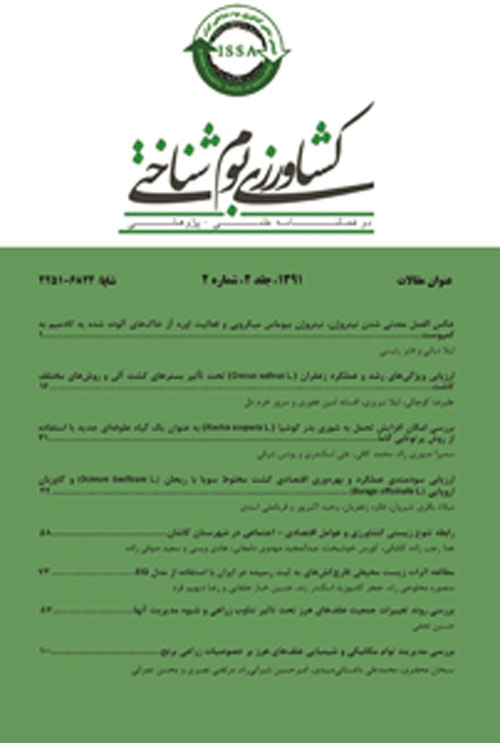The effect of winter rye (Secale cereale L.) as a cover crop on weed biomass, density and yield of forage maize (Zea mays L.)
Author(s):
Abstract:
Introduction
Today, the use of cover crops by farmers has its own economical approval with the benefit of reducing herbicide application through improved soil conditions and crop yield. Among the various plants, rye is the most suitable for use as a cover plant due to its high biomass production and allelopathic compounds.Materials And Methods
In order to the evaluate the effects of different levels of rye densities and planting dates on the density and biomass of weeds in a forage maize field, a factorial experiment was conducted with a randomized complete block design with three replications at the agricultural research station in Ardabil. The first factor was the rye planting date at an interval of 15 days: (25 April, 10 May, 25 May and 10 June). The second factor was the rye planting densities that included (0 kg, 80 kg, 120 kg, and 160 kg per ha). To investigate the effect of rye on density and weed biomass, a weed sampling was conducted in two stages. The first stage was done at 8 leaves of maize and the second was done a week before tasselling of maize on the basis of 0.5 by 0.5 meters. Also measured were ear weight, length, and diameter, and shoot fresh weight, stem diameter, and fresh forage yield of maize.Results And Discussion
The results showed that the density and biomass of annual and perennial weeds were influenced by the main and interactive effects of the rye planting by date × plant density. Due to their allelopathic features, cover crops can control weed growth, bring about higher growth rates and rooting power, as well as help preserve the earth with suitable covering at early planting dates (Tobeh et al., 1999). In an experiment with soybeans, rye as a cover crop reduced weed biomass 60% to 90% due to its allelopathic effect (Ateh and Doll, 1996). In general, the first planting date of rye (one month prior to the planting of corn) had the greatest effect on reducing the density and dry weight of weeds. The first planting date by the third density, reduced the density of the annual weeds by 89% and its dry weight by 93%. Perennial weeds were reduced by 83 percent and their dry weight by 92 percent. In spring planting, because of a lack of rye vernalization, there would be no troublesome new weeds, because the plant cannot reproduce by itself within a few months in most areas. This disappearance of rye adds to the appropriate control of weeds. Weed control by rye leads to enhanced competitiveness of maize and increases forage yield, cob fresh weight, length, diameter, stem fresh weight, and the diameter of maize. The main effect of the density with the highest density of rye (third density), is that it is more likely to be competitive with maize, reducing the availability of nitrogen, the release of allelopathic materials and soil cooling. This resulted in significant reduction in maize yield components. The combination of the optimum planting date (third planting date) along with greater weed control, resulted in a significant increase in maize yield. Reduction of cover crops residue, especially small grains, is related to reduced nitrogen availability, reduced toxins and lower soil temperatures (Westgate et al., 2005; Norsworthy, 2004).Conclusion
Together with the optimum planting dates and density, the use of cover crops, especially rye, is generally a good choice to control weeds in corn fields.Keywords:
Language:
Persian
Published:
Journal of Agroecology, Volume:7 Issue: 1, 2017
Page:
139
magiran.com/p1733932
دانلود و مطالعه متن این مقاله با یکی از روشهای زیر امکان پذیر است:
اشتراک شخصی
با عضویت و پرداخت آنلاین حق اشتراک یکساله به مبلغ 1,390,000ريال میتوانید 70 عنوان مطلب دانلود کنید!
اشتراک سازمانی
به کتابخانه دانشگاه یا محل کار خود پیشنهاد کنید تا اشتراک سازمانی این پایگاه را برای دسترسی نامحدود همه کاربران به متن مطالب تهیه نمایند!
توجه!
- حق عضویت دریافتی صرف حمایت از نشریات عضو و نگهداری، تکمیل و توسعه مگیران میشود.
- پرداخت حق اشتراک و دانلود مقالات اجازه بازنشر آن در سایر رسانههای چاپی و دیجیتال را به کاربر نمیدهد.
دسترسی سراسری کاربران دانشگاه پیام نور!
اعضای هیئت علمی و دانشجویان دانشگاه پیام نور در سراسر کشور، در صورت ثبت نام با ایمیل دانشگاهی، تا پایان فروردین ماه 1403 به مقالات سایت دسترسی خواهند داشت!
In order to view content subscription is required
Personal subscription
Subscribe magiran.com for 70 € euros via PayPal and download 70 articles during a year.
Organization subscription
Please contact us to subscribe your university or library for unlimited access!



